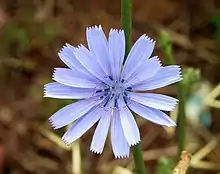Cichorioideae
The Cichorioideae are a subfamily of the family Asteraceae of flowering plants. Familiar members of Cichorioideae include lettuce, dandelions, chicory and Gazania species. The subfamily comprises about 240 genera and about 2900 species. It is heterogeneous and hard to characterize except with molecular characters.
| Cichorioideae | |
|---|---|
 | |
| Cichorium intybus | |
| Scientific classification | |
| Kingdom: | Plantae |
| Clade: | Tracheophytes |
| Clade: | Angiosperms |
| Clade: | Eudicots |
| Clade: | Asterids |
| Order: | Asterales |
| Family: | Asteraceae |
| Subfamily: | Cichorioideae Chevallier |
| Tribes | |
|
See text | |
Taxonomy
The subfamily as understood in 1998 turned out to be paraphyletic, based on studies of DNA sequences,[1] so a number of tribes were moved to new subfamilies. Names for the new subfamilies were published in 2002.[2] In 2004, 2007, and 2008, molecular phylogenetic studies further clarified relationships within Cichorioideae.[3][4][5]
Major works on Asteraceae were published in 2007 and 2009. These were the only comprehensive treatments of the family since 1994.[6] In the 2007 book, Gundelia and Warionia were segregated from the tribe Cichorieae to form the tribe Gundelieae. Eremothamnus, Hoplophyllum, Heterolepis, and Platycarpha were placed incertae sedis in tribe Arctotideae, while Distephanus, Trichospira, Moquinia, and Pseudostifftia were placed in the tribe Vernonieae.[7] Some of this classification was not supported by phylogenetic studies that came out later.[8][5] For example, the tribe Arctotideae was only weakly supported as monophyletic, but its two subtribes, Arctotidinae and Gorteriinae, were strongly supported.
In the 2009 book, the Gundelieae were sunk into the Cichorieae. The new tribe Platycarpheae was recognized, as well as the tribes Eremothamneae and Moquinieae. Heterolepis was placed in the Arctotideae, at least provisionally. Distephanus was not placed in the Moquinieae or the Vernonieae, but is closely related to them.[9] Trichospira was placed in the Vernonieae, but its inclusion there is in doubt.
Phylogeny
The following phylogeny is from Systematics, Evolution and Biogeography of the Compositae, except the tribe Gundelieae is recognized and the genus Trichospira is now included in Vernonieae.
| Cichorioideae |
| ||||||||||||||||||||||||||||||||||||||||||||||||
References
- Bayer, Randall J.; Starr, Julian R. (1998). "Tribal Phylogeny of the Asteraceae Based on Two Non-Coding Chloroplast Sequences, the trnL Intron and trnL/trnF Intergenic Spacer". Annals of the Missouri Botanical Garden. 85 (2): 242–256. doi:10.2307/2992008. JSTOR 2992008.
- Jose L. Panero; Vicki A. Funk (2002-12-30). "Toward a phylogenetic subfamilial classification for the Compositae (Asteraceae)" (PDF). Proceedings of the Biological Society of Washington. Biological Society of Washington. 115 (4): 909–922. Archived from the original (PDF) on 2006-09-14. Retrieved 2007-08-12.
- Funk, Vicki A.; Chan, Raymund; Keeley, Sterling C. (2004). "Insights into the Evolution of the Tribe Arctoteae (Compositae: Subfamily Cichorioideae s.s.) Using trnL-F, ndhF, and ITS". Taxon. 53 (3): 637–655. doi:10.2307/4135440. JSTOR 4135440.
- Sterling C. Keeley, Zac H. Forsman, and Raymund Chan. 2007. "A phylogeny of the "evil tribe" (Vernonieae: Compositae) reveals Old/New World long distance dispersal: Support from separate and combined congruent datasets (trnL-F, ndhF, ITS)". Molecular Phylogenetics and Evolution 44(1):89-103.
- Jose L. Panero and Vicki A. Funk. 2008. "The value of sampling anomalous taxa in phylogenetic studies: Major clades of the Asteraceae revealed". Molecular Phylogenetics and Evolution 47(2):757–782.
- Kåre Bremer (with the assistance of Arne A. Anderberg, Per Ola Karis, Bertil Nordenstam, Johannes Lundberg, and Olof Ryding). 1994. Asteraceae: cladistics and classification. Timber Press: Oregon, USA. ISBN 978-0-88192-275-2.
- Klaus Kubitzki (series editor); Joachim W. Kadereit and Charles Jeffrey (volume editors). The Families and Genera of Vascular Plants volume VIII. Springer-Verlag: Berlin; Heidelberg, Germany. ISBN 978-3-540-31050-1
- Vicki A. Funk; Raymund Chan; Stirling C. Keeley (2004). "Insights into the evolution of the tribe Arctoteae (Compositae: subfamily Cichorioideae s.s.) using trnL-F, ndhF, and ITS" (PDF). Taxon. 53 (3): 637–655. doi:10.2307/4135440. JSTOR 4135440.
- Vicki A. Funk, Alfonso Susanna, Tod F. Stuessy, and Randall J. Bayer. 2009. Systematics, Evolution and Biogeography of the Compositae. IAPT (International Association for Plant Taxonomy). ISBN 978-3-9501754-3-1 (see External links below).
External links
- Classification (compositae book, chapter 11 At: The International Compositae Alliance
- Cichorioideae At: Tree of Life
- Phylogenetic Analysis of the Cichorioideae (Asteraceae), with Emphasis on the Mutisieae
- UniProt. "Subfamily Cichorioideae". Retrieved 2008-06-30. At: Uniprot Taxonomy At: Uniprot
 The dictionary definition of Cichorioideae at Wiktionary
The dictionary definition of Cichorioideae at Wiktionary Media related to Cichorioideae at Wikimedia Commons
Media related to Cichorioideae at Wikimedia Commons Data related to Cichorioideae at Wikispecies
Data related to Cichorioideae at Wikispecies